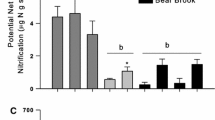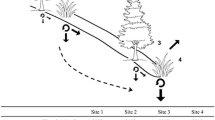Abstract
We measured aboveground biomass and aboveground net primary productivity (ANPP), groundwater depth and fluctuation, andin situ nitrogen (N) mineralization in 13 upland and 4 wetland forest stands at Cedar Creek Natural History Area (CCNHA). The area, in east central Minnesota (45°25′ N, 93°10′ W), is on well-sorted glacial outwash of very uniform fine sand. Uplands are interspersed with peadands and the area has shallow groundwater. Stands were aggregated into six ecosystem types based on overstory composition: oak, pine-oak, mesic hardwoods, northern white-cedar, lowland hardwoods, and savanna. Aboveground overstory biomass ranged from 35 to 250 Mg ha−1; lowest in the savanna and highest in the pine-oak. The ANPP ranged from about 2 to 7.5 Mg ha−1; also lowest in the savanna but highest in the white-cedar. Over all types, the annual aboveground uptake of N was poorly related to available N measured byin situ mineralization (r 2 = 0.01), but the relationship was better (r 2 = 0.88) if N availability in the wetland stands was assumed to be a fixed proportion of N in the surface soil (1.5%). Over all types,in situ N mineralization was poorly related to ANPP (r 2 = 0.05) and biomass (r 2 = 0.38). Both ANPP and overstory biomass were more closely related to groundwater fluctuation (r 2 = 0.87 and 0.28, respectively) than to depth (r 2 = 0.01 and 0.21, respectively)). The strength of all relationships varied with the inclusion or exclusion of data from the wetland types or the savanna. Total soil N and rates of mineralization were inversely related (r2 = 0.42) because of data from wetland stands. Results demonstrate that the positive relationships between aboveground productivity and measuredin situ N mineralization observed in upland forests are not valid for the landscape that includes wetland forests either becausein situ measurements do not indicate N availability in wetlands or because of the presence of other limiting factors. The north temperate landscape includes an abundance of wetland forests with potentially strong linkages to uplands. This study suggests that the commonly-used measure of N availability provides inconsistent information about controls on ecosystems processes in this diverse landscape.
Similar content being viewed by others
Abbreviations
- ANPP:
-
aboveground net primary productivity
- CCNHA:
-
Cedar Creek National History Area
References
Alemdag IS (1983) Mass equations and merchantability factors for Ontario softwoods. Canadian Forestry Service, Petawawa National Forestry Institute. Information Report PI-X-23. 27 pp
Alemdag IS (1984) Total tree and merchantable stem biomass equations for Ontario hardwoods. Canadian Forestry Service, Petawawa National Forestry Institute. Information Report PIX-46. 54 pp
Allen HL (1987) Forest fertilizers. Journal Forestry 85: 37–46
Anderson DW (1988) The effect of parent material and soil development on nutrient cycling in temperate ecosystems. Biogeochemistry 5: 71–97
Binkley D & Hart SC (1989) The components of nitrogen availability assessments in forest soils. Advances in Soil Science 10: 57–112
Davidson EA & Swank WT (1987) Factors limiting denitrification in soils from mature and disturbed southeastern hardwood forests. Forest Science 33: 135–144
Dyck WJ, Messina MG & Hunter IR (1986) Predicting the nutritional consequences of forest harvesting on site productivity. In: Agren GI (Ed) Predicting Consequences of Intensive Forest Harvesting on Long-Term Productivity (pp 9–29). Department of Ecology and Environmental Research, Swedish University of Agricultural Science, Report 26
Eno CF (1960) Nitrate production in the field by incubating the soil in polyethylene bags. Soil Science Society America Proceedings 24: 277–279
Gower ST & Son Y (1992) Differences in soil and leaf litterfall nitrogen dynamics for five forest plantations. Soil Science Society America Journal 56: 1959–1966
Grigal DF (1991) Elemental dynamics in forested bogs in northern Minnesota. Canadian Journal Botany 69: 539–546
Grigal DF, Chamberlain LM, Finney HR, Wroblewski DV & Gross ER (1974) Soils of the Cedar Creek Natural History Area. Miscellaneous Report 123, University of Minnesota Agricultural Experiment Station, St. Paul, MN, USA
Groffman PM & Tiedje JM (1989) Denitrification in north temperate forest soils: spatial and temporal patterns at the landscape and seasonal scales. Soil Biology and Biochemistry 21: 613–620
Miner CL, Walters NR & Belli ML (1988) A guide to the TWIGS program for the North Central United States. USDA Forest Service General Technical Report NC-125. 105 pp
Mladenoff DJ (1987) Dynamics of nitrogen and nitrification in hemlock and hardwood treefall gaps. Ecology 68: 1171–1180
Nadelhoffer NJ, Aber JD & Melillo JM (1983) Leaf-litter production and soil organic matter dynamics along a nitrogen-availability gradient in southern Wisconsin. Canadian Journal of Forest Research 13: 12–21
Pastor J, Aber JD, McClaugherty CA & Melillo JM (1982) Geology, soils and vegetation of Blackhawk Island, Wisconsin. American Midland Naturalist 108: 266–277
Pastor J, Aber JD, McClaugherty CA & Melillo JM (1984) Aboveground production and N and P cycling along a nitrogen mineralization gradient on Blackhawk Island, Wisconsin. Ecology 65: 256–268
Pastor J, Stillwell MA & Tilman D (1987) Nitrogen mineralization and nitrification in four Minnesota old fields. Oecologia 71: 481–485
Smith CW (1978) Bayes least significant difference: a review and comparison. Agronomy Journal 70: 123–127
Snedecor GW & Cochran WG (1967) Statistical methods. 6th ed. Iowa State University Press, Ames, IA
Tilman D (1986) Nitrogen-limited growth in plants from different successional stages. Ecology 67: 555–563
Vitousek PM (1982) Nutrient cycling and nutrient use efficiency. American Naturalist 119: 553–572
Vitousek PM, Gosz JR, Grier CC, Melillo JM & Reiners WA (1982) A comparative analysis of potential nitrification and nitrate mobility in forest ecosystems. Ecological Monographs 52: 155–177
Wilkinson L (1986) SYSTAT: The system for statistics. SYSTAT, Inc. Evanston, IL
Zak DR & Grigal DF (1991) Nitrogen cycling in upland and wetland ecosystems of east-central Minnesota. Oecologia 88: 189–196
Zak DR, Host GE & Pregitzer KS (1989) Regional variability in nitrogen mineralization, nitrification and overstory biomass in northern Lower Michigan. Canadian Journal of Forest Research 19: 1521–1526
Zak DR, Hairston AB & Grigal DF (1990) Topographic influences on nitrogen cycling within an upland pin oak ecosystem. Forest Science 37: 45–53
Author information
Authors and Affiliations
Rights and permissions
About this article
Cite this article
Grigal, D.F., Homann, P.S. Nitrogen mineralization, groundwater dynamics, and forest growth on a Minnesota outwash landscape. Biogeochemistry 27, 171–185 (1994). https://doi.org/10.1007/BF00000583
Accepted:
Issue Date:
DOI: https://doi.org/10.1007/BF00000583




